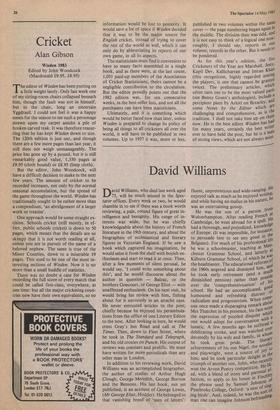Cricket
Alan Gibson
Wisden 1983
Edited by John Woodcock (Macdonald £9.95, £8.95)
The editor of Wisden has been putting on a little weight lately. Only last week one of my sitting-room chairs collapsed beneath him, though the fault was not in himself, but in the chair, long an uncertain Yggdrasil. I could not feel it was a happy omen for the season to see such a personage strewn upon my carpet amidst a pile of broken carved teak. It was therefore reasur- ring that he has kept Wisden down to size. The 120th edition is just out, and though there are a few more pages than last year, it still does not weigh unmanageably. The price has gone up by a pound, but it is still remarkably good value, 1,330 pages at £9.95 (cloth bound) or £8.95 (limp cloth).
But the editor, John Woodcock, will have a difficult decision to make in the next few years. The amount of cricket to be recorded increases, not only by the normal seasonal accumulation, but the spread of the game throughout the world. Wisden has traditionally sought to be rather more than a compendium, 'an abridgement of a larger work or treatise'.
One approach would be some straight ex- cision. Schools cricket (still mostly, in ef- fect, public schools cricket) is down to 50 pages, which means that the details are so skimpy that it is not worth reading at all, unless you are in pursuit of the name of a beloved nephew. The same is true of the Minor Counties, down to a miserable 19 pages. This used to be one of the most in- teresting sections of Wisden. Now it is no more than a small huddle of statistics.
There was no doubt a case for Wisden recording the full score of every match that could be called first-class, everywhere, at one time: but all the major cricketing coun- tries now have their own equivalents, so no information would be lost to posterity. It would save a lot of space if Wisden decided that it was to be the major source for English cricket, instead of trying to cover the rest of the world as well, which it can only do by abbreviating its reports of our own game, in all its aspects.
The statisticians must find it convenient to have so many facts assembled in a single book, and as there were, at the last count, 1,031 paid-up members of the Association of Cricket Statisticians, theirs cannot be a negligible contribution to the circulation. But the editor proudly points out that the 1982 edition was, for ten consecutive weeks, in the best-seller lists, and not all the purchasers can have been statisticians.
Ultimately, and it is something which would be better faced now than later, unless Wisden is prepared to change its policy of being all things to all cricketers all over the world, it will have to be published in two volumes. Up to 1937 it was, more or less, published in two volumes within the same cover — the page numbering began again in the middle. The division then was odd, and it is not easy to think of a logical one now: roughly, I should say, reports in one volume, records in the other. But it needs to be pondered.
As for this year's edition, the five Cricketers of the Year are Marshall, Jesty, Kapil Dev, Kallicharran and Imran Khan (this recognition, highly regarded among the players, is one that cannot be granted twice). The preliminary articles, which often turn out to be the most valued Parts (see Benny Green's anthologies), include a percipient piece by Arlott on Brearley, and some Notes by the Editor which are challenging and comprehensive, as is the tradition, I shall not take him up on then; now. He is the best editor Wisden has illa" for many years, certainly the best writer ever to have held the post, but he is a roan of strong views, which are not always mine.










































 Previous page
Previous page